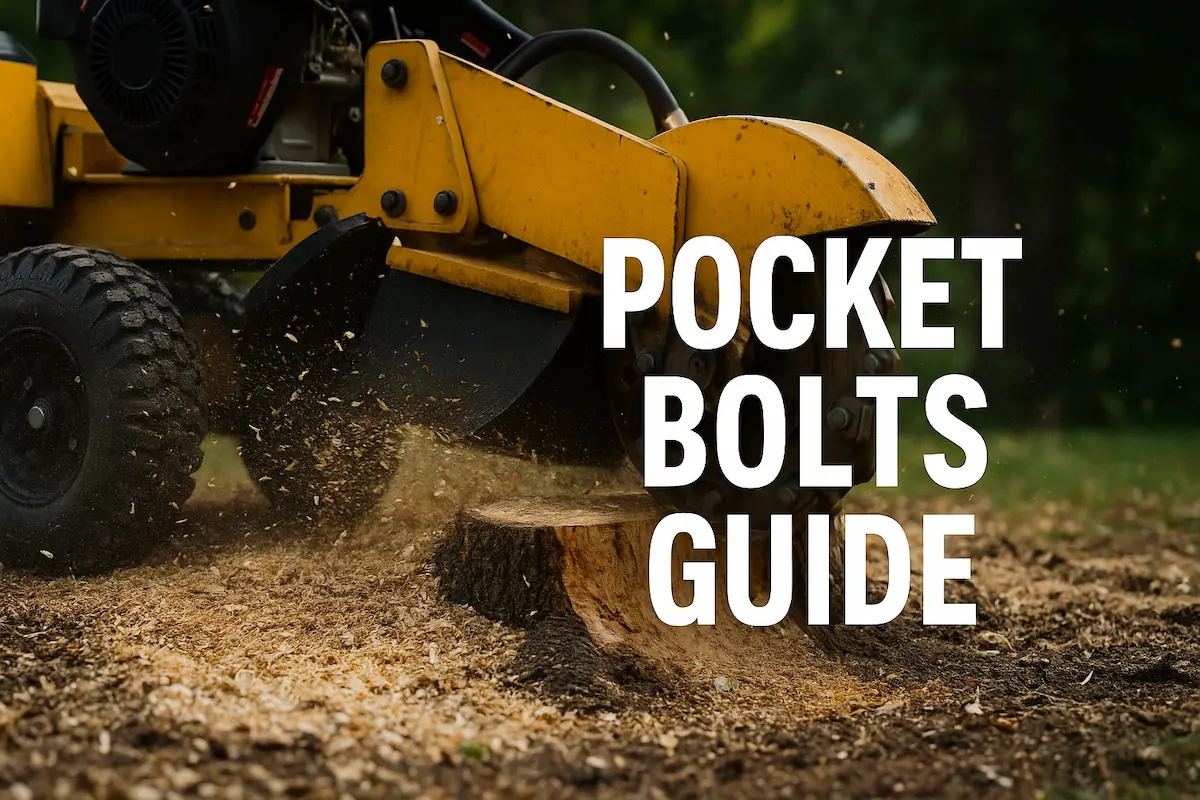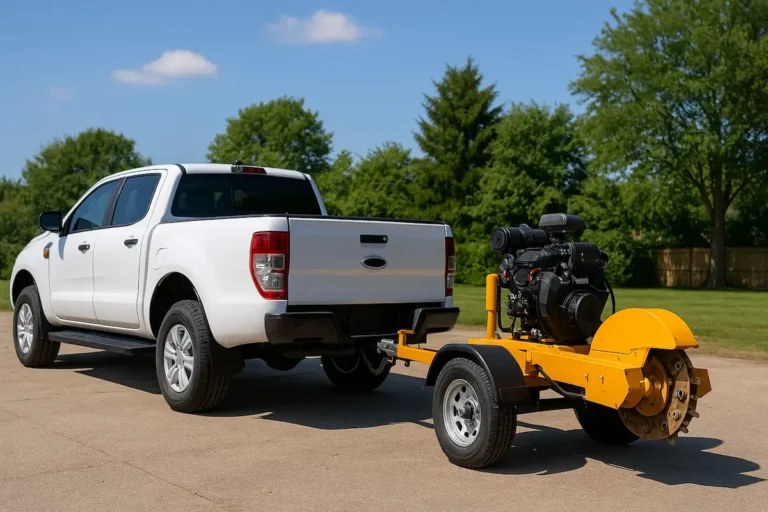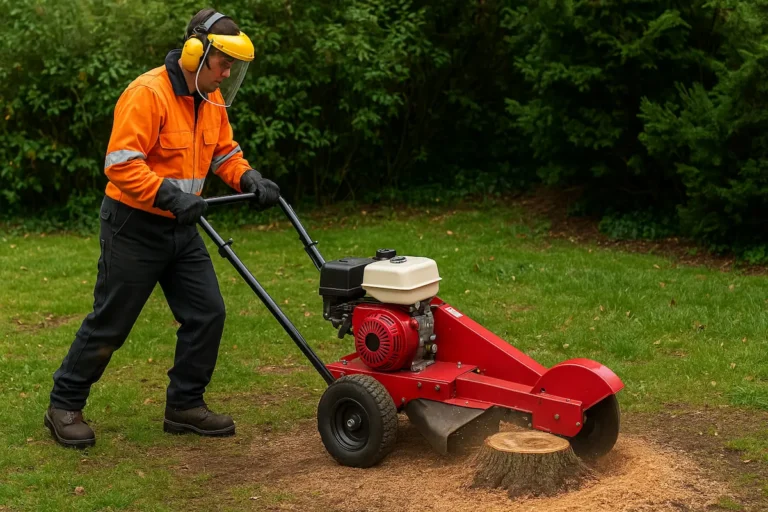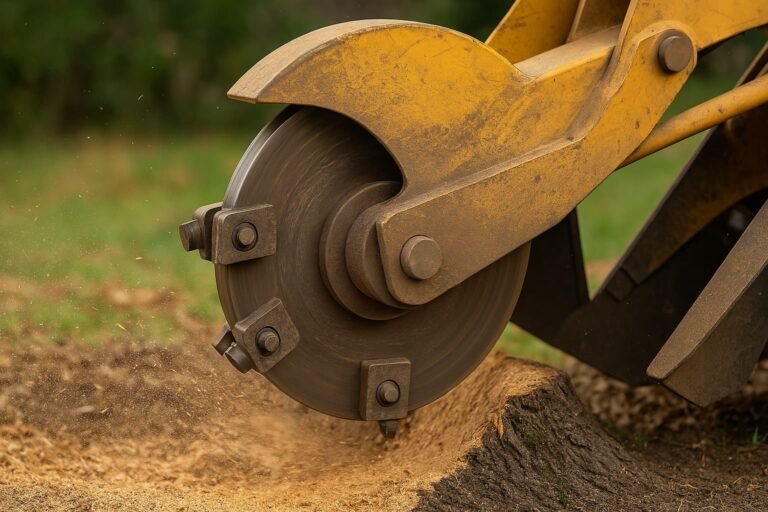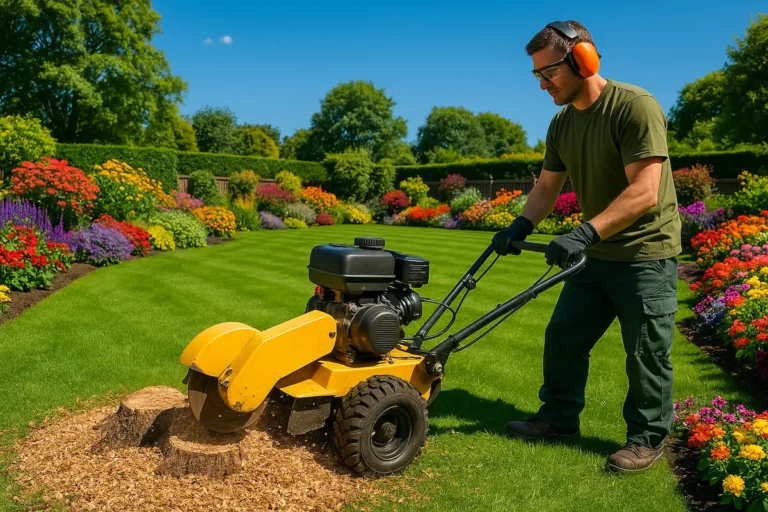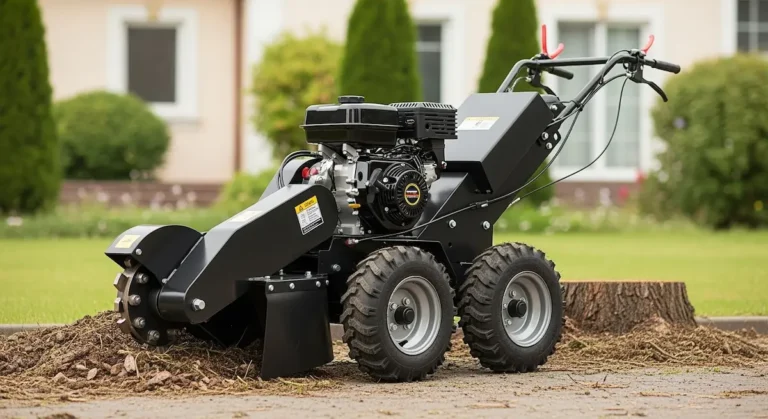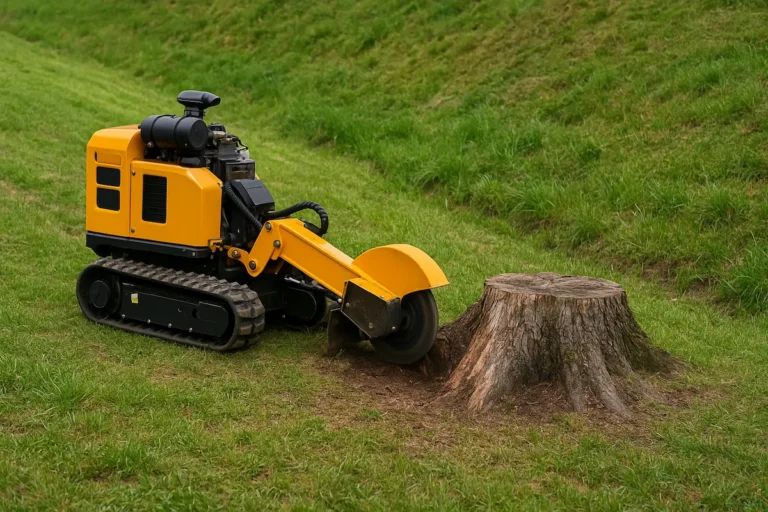What Are Pocket Bolts and Why They Matter on Your Hire Stump Grinder
Pocket bolts hold the sharp teeth onto your hire stump grinder.
They are super important for safety and getting the job done right.
This guide explains what they are and what simple checks you should do.
Key Takeaways: Pocket Bolt Torque
- The chart highlights the manufacturer-recommended torque for common stump grinder pocket bolts, specifically the ~120 ft-lbs often specified for GreenTeeth® LoPro™ systems.
- Correct torque is critical: It ensures the cutting tooth is held securely without stressing the bolt or pocket.
- Too Loose: Can cause dangerous vibration, inefficient grinding, excessive wear, and the catastrophic risk of the tooth flying off.
- Too Tight: Can stretch or weaken the bolt, potentially causing it to snap under stress (e.g., hitting a rock), or damage the pocket threads.
- Hire Company Responsibility: We use calibrated torque wrenches to set the correct tension during maintenance.
- Your Role: Perform a visual check for obvious issues (loose/missing/damaged bolts) before use and report any concerns immediately. Do not attempt to tighten bolts yourself.
Defining the “Pocket Bolt”: The Key to Secure Grinder Teeth
A pocket bolt is a special, strong bolt.
Its job is to hold a cutting tooth firmly in its holder, called a ‘pocket’.
Think of the tooth as the blade, the pocket as the handle, and the pocket bolt as the screw, keeping them tightly together.
These pockets are then fixed onto the big spinning wheel of the stump grinder.
Many hire stump grinders, like the ones we offer, use a system called GreenTeeth®.
These systems often use a single, strong pocket bolt for each tooth holder.
This makes checking them easier.
These bolts must be powerful because grinding stumps puts a lot of stress on them.
They are usually made of high-strength steel, often called Grade 8.
This means they can handle the shaking and banging during grinding.
The bolt ensures the tooth stays exactly where it should be while the wheel spins quickly.
If the bolt is loose or breaks, the tooth could fly off, which is dangerous.
So, this small bolt plays a massive part in how the grinder works safely and effectively.
Visual Guide: Identifying Pocket Bolts on Our Hire Equipment
Look at the big cutting wheel on the stump grinder.
You will see several sharp teeth spaced around it.
Each tooth sits in a metal holder, which we call a pocket.
The pocket bolt is the fastener, usually with a hex head (for a spanner) or an Allen key head (a hole with six sides), that goes through the pocket to hold the tooth tight.
On systems like GreenTeeth®, there’s usually just one central bolt per pocket you need to look at.
It might be on the side or front of the pocket.
Take a moment to spot these bolts before you start the machine.
Knowing what you’re looking for helps you do a quick safety check.
Remember where they are – they are key safety parts.
Why Pocket Bolt Integrity is Crucial for Your Safety
Your safety is our top priority when you hire a stump grinder.
Pocket bolts are small parts, but they are critical for safe operation.
The grinder wheel spins incredibly fast while chewing through tough wood.
Imagine the force on each tooth!
The pocket bolt’s job is to keep that tooth locked securely.
If a bolt fails – maybe it snaps or comes loose – the heavy, sharp tooth could be thrown off the wheel at high speed.
This could cause serious injury to you or anyone nearby.
It could also severely damage property.
Loose bolts can also cause the grinder to vibrate badly.
This makes the machine more challenging to control and less effective.
It also puts extra strain on other parts of the grinder.
Secure bolts = Safer grinding.
That’s why checking them is part of using the machine responsibly.
We check them carefully as part of our maintenance.
But a quick look before you start adds an extra layer of safety.
The Vital Role of Correct Bolt Tension (Torque)
‘Torque’ is just a word for how tight the bolt is screwed in.
Getting the pocket bolt tension exactly right is very important.
It’s a bit like the nuts on a car wheel.
The wheel could wobble or even come off if they are too loose.
The bolt (or stud) could be damaged or broken if they are too tight.
Pocket bolts are the same.
If a pocket bolt is too loose:
- It can vibrate and wear out the pocket or the bolt itself.
- The tooth might move around, making grinding less efficient.
- The bolt could eventually work itself completely loose.
- The tooth could fly off – the most dangerous risk.
If a pocket bolt is too tight:
- The bolt can be stretched or weakened.
- It might snap suddenly under stress, especially if hitting a stone.
- The threads in the pocket could get damaged.
Manufacturers give a specific torque setting for their pocket bolts.
For example, the standard GreenTeeth® LoPro™ system often needs about 120 foot-pounds (ft-lbs) of torque.
That’s quite tight, similar to many car wheel nuts.
How We Ensure Correct Torque Before Your Hire
You don’t need to worry about getting the torque perfect yourself.
That’s our job.
We use special tools called torque wrenches during our maintenance checks.
These tools let us tighten each pocket bolt to the exact setting recommended by the maker.
This ensures the bolts are secure but not over-stressed.
We regularly inspect and maintain all our hire grinders’ teeth, pockets, and bolts.
This includes checking the torque and replacing any worn or damaged parts.
So, when you hire from us, the bolts should already be correctly tensioned.
You do a quick visual check for any obvious problems before you start.
Knowing why torque matters helps you understand the importance of reporting any issues you spot.
Your Pre-Hire Check: Safely Inspecting the Grinder Teeth Bolts
Doing a quick check before you start grinding is a smart safety habit.
It only takes a minute or two.
Here’s how to do it safely:
Step 1: Ensure the Machine is Off and Stable
Safety first, always!
Make sure the stump grinder engine is completely switched off.
The machine should be parked on flat, stable ground.
Wait for all moving parts, especially the cutter wheel, to stop completely.
Remove the key from the ignition if possible.
Never inspect the wheel while the engine is running or still warm.
Step 2: Look for Obviously Loose or Missing Bolts
Carefully look at each tooth and pocket around the cutter wheel.
Focus on the pocket bolts.
Do any bolts look like they are sticking out more than others?
Does the gap around the bolt head look uneven?
Can you see any bolts that are entirely missing?
A missing bolt is a definite stop sign. Do not use the machine.
Also, gently wiggle each tooth (carefully, wear gloves!). It should feel solid.
If a tooth feels wobbly, the bolt might be loose.
Step 3: Check for Damaged Bolts or Pockets
Look closely at the head of each pocket bolt.
Is the head stripped or rounded off? (Where the spanner or Allen key goes).
Are there any cracks in the bolt head or the pocket around it?
Is the area around the bolt showing signs of excessive wear or damage?
Look for bolts that might be bent or sheared (broken off).
Damage to the bolt or pocket means the connection isn’t secure.
Critical Safety Notice: Report Any Concerns Immediately
This is important: Your check is visual only.
Do NOT try to tighten the pocket bolts yourself.
You don’t need the special torque wrench to set the correct tension.
Tightening it incorrectly could make things worse or hide a bigger problem.
If you see ANYTHING that worries you:
- A missing bolt
- A loose-looking bolt
- A wobbly tooth
- A damaged bolt head
- Cracks in the pocket
- Anything else that doesn’t look right…
STOP. Do not start the grinder.
Contact us immediately.
Call the hire number provided.
Explain what you have seen.
We will advise you on what to do next.
It might be a simple fix, but we can guide you through reporting, or we might need to swap the machine.
Your safety depends on reporting concerns before you start work.
Recognising Potential Problems While Grinding
Sometimes, issues with pocket bolts only become apparent once you start working.
Keep your senses tuned while operating the grinder.
Increased Vibration: A Possible Sign of Trouble
All stump grinders vibrate, but you’ll get used to the normal level.
If the machine suddenly starts vibrating much more than usual.
Or if it feels rough and unbalanced.
This could be a sign that a tooth has come loose or a bolt has failed.
An unbalanced wheel spinning fast creates strong vibrations.
Unusual Noises: Listening for Warning Sounds
Listen to the sounds the grinder makes during operation.
If you hear sudden loud clanking, banging, or metallic grinding noises that weren’t there before.
These could indicate a loose part, like a tooth hitting the guards or a broken bolt.
Don’t ignore strange new noises.
What to Do: Stop Grinding and Contact Us Immediately
If you notice excessive vibration or hear worrying noises:
- Immediately stop grinding. Release the controls that engage the cutter wheel.
- Move away from the stump.
- Turn off the engine completely.
- Wait for everything to stop moving.
- Do NOT try to investigate the cutter wheel yourself immediately after stopping. Parts can be hot or under tension.
- Contact us straight away. Describe the vibration or noise.
We must know about these issues immediately to ensure safety and prevent further damage.
Do not continue using a machine that feels or sounds wrong.
Quick Visual Check Summary
- Machine OFF? ✅ Yes, completely off and stable.
- Look for Missing Bolts. ✅ Check every pocket.
- Look for Loose Bolts? ✅ Check if any look uneven or sticking out.
- Check Tooth Wobble? ✅ Gently check if teeth feel solid (wear gloves!).
- Look for Damage? ✅ Check bolt heads and pockets for cracks or wear.
- Problem Found? 🛑 STOP! DO NOT USE! CALL US!
- All Looks OK? 👍 Proceed with caution; stay alert while grinding.
Understanding Common Pocket Bolt Issues (Why Checks Matter)
Knowing the common problems helps you understand why these checks are essential.
Pocket bolts work under harsh conditions. Here’s what can sometimes happen:
- Bolts Loosening: Vibrations can slowly work bolts loose if they aren’t perfectly torqued or threads worn. This is why checking for looseness is key. One user on a forum mentioned, “Check your bolts are tight before every job! I had one loosen up, and the tooth flew off mid-grind.” (Paraphrased) That’s a situation everyone wants to avoid.
- Bolts Shearing (Breaking): Hitting hidden objects like rocks, metal bars, or tough roots puts sudden, tremendous stress on the teeth and bolts. Sometimes, even a strong bolt can snap under this impact. A forum user shared, “Hit a hidden chunk of concrete, sheared three pocket bolts instantly. Annoying but part of the job.” (Paraphrased) While unavoidable sometimes, ensuring bolts aren’t already weak from incorrect torque helps.
- Bolt Head Damage: Using the wrong size or worn tools can strip the Allen key socket or round off the hex head, making proper tightening or removal difficult.
- Bolt Seizing: Dirt, debris, and rust can sometimes make bolts hard to remove. While this is more of our maintenance issue, checking that the bolts look OK helps spot potential problems early.
- Incorrect Torque Issues: As discussed, wrong torque is a significant cause of problems. A user on Reddit admitted, “Learned the hard way. Overtightened and snapped two bolts clean off.” (Paraphrased) This highlights why we use torque wrenches and why hirers shouldn’t guess at tightening.
Case Study Example 1: The Importance of Reporting
A hirer notices heavy vibrations soon after starting a job. Instead of ignoring it, they stopped and called us. We asked them to check the teeth bolts visually from a safe distance. They reported one bolt head looked sheared off. We immediately arranged for a replacement machine. Their quick reporting prevented potential injury or further damage.
Case Study Example 2: The Hidden Rock
Another customer was grinding an old stump and hit a large, buried rock. They heard a loud bang and stopped the machine. On checking, they found two pocket bolts had broken. They called us, and we confirmed this can happen with unexpected impacts. We provided guidance and arranged support. Knowing that impacts can break bolts helps users understand why stopping after a brutal hit is wise.
These examples show why your visual checks and paying attention during use are so valuable. They are simple steps that make a big difference to safety.
Our Maintenance Promise: Keeping Our Grinders Safe and Ready
We want you to have a safe and successful stump grinding experience.
That’s why we take maintenance very seriously.
Pocket bolts are a key part of our regular service checks.
Here’s what we do:
- Regular Inspections: After hires, our team inspects the cutter wheel, teeth, pockets, and bolts on every grinder.
- Torque Checks: We use calibrated torque wrenches to check and adjust pocket bolt tension to the manufacturer’s specification (like the ~120 ft-lbs / ~163 Nm often needed for GreenTeeth® LoPro™).
- Component Replacement: We replace bolts showing signs of wear, stretching, damage, or fatigue. We don’t reuse bolts excessively, as this can weaken them. We use high-quality, Grade 8 or equivalent bolts recommended for the system.
- Pocket Cleaning: When changing teeth or bolts, we clean debris from the pockets. This ensures the tooth sits correctly and the bolt tightens properly.
- Tooth Rotation/Replacement: We check the teeth for wear and rotate or replace them as needed. Sharp teeth cut better and put less stress on the bolts.
- Full Machine Check: Pocket bolts are just one part of our overall pre-hire check, which covers the engine, belts, guards, controls, and all safety features.
We invest time and resources into maintenance.
This helps ensure the stump grinder you hire is in good, safe working order.
Your pre-hire visual check is an important final step before you start work.
It partners with our maintenance routine for maximum safety.
Trust that we are doing our part behind the scenes.
Your part is to check and report any concerns quickly.
Frequently Asked Questions about Pocket Bolts on Hire Grinders
Here are some common questions hirers might have:
Should I bring tools to tighten the pocket bolts myself?
No, please do not. Pocket bolts need particular tightness (torque). Regular tools without a torque wrench can lead to overtightening (breaking the bolt) or under-tightening (the bolt coming loose). Your visual check is essential, but always report any concerns to us instead of trying to fix them yourself.
What happens if a bolt breaks or a tooth comes loose during my hire period?
Stop using the machine immediately and safely. Turn off the engine. Contact us straight away. Do not try to continue grinding. We will provide instructions and arrange for support, which might involve replacing the machine or giving replacement parts if safe and appropriate. Your safety is the priority.
Are GreenTeeth® pocket bolts standard on all your grinders?
Many of our grinders use the popular GreenTeeth® system, known for its easy-to-manage single-pocket bolt design. However, our fleet may include grinders with different tooth systems. The basic safety check principle remains the same: look for loose or damaged teeth and bolts before starting. If you have questions about the specific machine you hire, ask!
What if a bolt looks rusty? Is that a problem?
A little surface rust on a bolt head is often just cosmetic and doesn’t affect strength. However, when you report your checks, it’s worth mentioning whether the rust looks very deep or the bolt or pocket area looks badly corroded. We replace bolts that show excessive corrosion during maintenance.
Why can’t I use any bolt from a hardware shop if one is missing?
Pocket bolts are special high-strength bolts (often Grade 8) designed to handle extreme forces. Ordinary hardware store bolts are usually not strong enough. Using the wrong bolt type is dangerous as it could easily break under load. Always use the specific bolts designed for the stump grinder system. You must report missing bolts to us so we can supply the correct, safe replacement.
Hire a Stump Grinder with Confidence
Understanding pocket bolts helps you use your hire stump grinder more safely.
Remember these key points:
- Pocket bolts hold the teeth securely.
- Check them visually before every use (Machine OFF!).
- Look for missing, loose, or damaged bolts/pockets.
- NEVER try to tighten them yourself.
- Report any concerns to us immediately.
- Stop grinding if you notice heavy vibrations or strange noises.
We maintain our machines carefully, including checking bolt torque.
Your quick checks add an extra layer of safety.
Book Your Professionally Maintained Stump Grinder Today
Ready to tackle those stumps?
You can hire a stump grinder from us, knowing it has been professionally checked and maintained.

